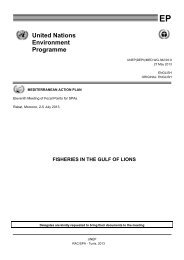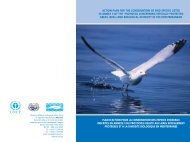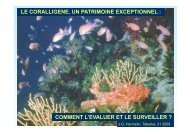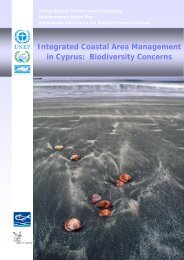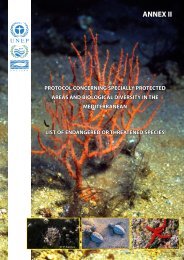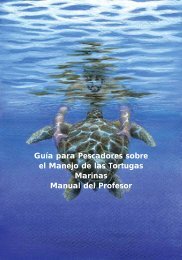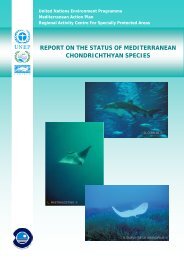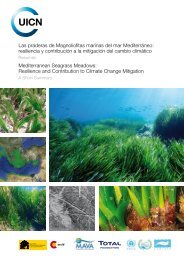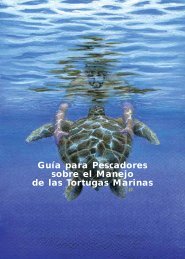Proceedings of the Second Mediterranean Symposium on Marine
Proceedings of the Second Mediterranean Symposium on Marine
Proceedings of the Second Mediterranean Symposium on Marine
Create successful ePaper yourself
Turn your PDF publications into a flip-book with our unique Google optimized e-Paper software.
PROCEEDINGS OF THE SECOND MEDITERRANEAN SYMPOSIUM ON MARINE VEGETATION (ATHENS, 12-13 DECEMBER 2003)<br />
218<br />
MATERIALS AND METHODS<br />
The indices were applied <strong>on</strong> existing data from <str<strong>on</strong>g>the</str<strong>on</strong>g> Maliakos Bay (Aegean Sea, Greece)<br />
(Chryssovergis & Panayotidis, 1995). The data was quantitative and c<strong>on</strong>sisted <str<strong>on</strong>g>of</str<strong>on</strong>g> a set <str<strong>on</strong>g>of</str<strong>on</strong>g> five<br />
stati<strong>on</strong>s al<strong>on</strong>g an eutr<str<strong>on</strong>g>of</str<strong>on</strong>g>icati<strong>on</strong> gradient (Fig. 1) for two years (summer and winter m<strong>on</strong>ths).<br />
Fig 1: Map <str<strong>on</strong>g>of</str<strong>on</strong>g> Maliakos Bay (Greece) showing <str<strong>on</strong>g>the</str<strong>on</strong>g> five sampling stati<strong>on</strong>s al<strong>on</strong>g a eutr<str<strong>on</strong>g>of</str<strong>on</strong>g>icati<strong>on</strong> gradient from<br />
<str<strong>on</strong>g>the</str<strong>on</strong>g> Sperchios River mouth (stati<strong>on</strong>s A & B), from were <str<strong>on</strong>g>the</str<strong>on</strong>g>re is an important nutrient input, towards <str<strong>on</strong>g>the</str<strong>on</strong>g><br />
Aegean Sea (stati<strong>on</strong>s C & E).<br />
The Ecological Evaluati<strong>on</strong> Index<br />
The EEI was calculated according to Orfanidis et al. (2001). The macrophyte species<br />
were divided in two Ecological State Groups. In ESG I were grouped <str<strong>on</strong>g>the</str<strong>on</strong>g> thick lea<str<strong>on</strong>g>the</str<strong>on</strong>g>ry,<br />
<str<strong>on</strong>g>the</str<strong>on</strong>g> articulate upright calcareous and <str<strong>on</strong>g>the</str<strong>on</strong>g> crustose calcareous species, most <str<strong>on</strong>g>of</str<strong>on</strong>g> <str<strong>on</strong>g>the</str<strong>on</strong>g>m being<br />
k-selected species. In ESG II were grouped <str<strong>on</strong>g>the</str<strong>on</strong>g> foliose, <str<strong>on</strong>g>the</str<strong>on</strong>g> filamentous and <str<strong>on</strong>g>the</str<strong>on</strong>g> coarsely<br />
branched upright species. Most <str<strong>on</strong>g>of</str<strong>on</strong>g> <str<strong>on</strong>g>the</str<strong>on</strong>g>m are r-selected species. Each sampling site was<br />
classified in <strong>on</strong>e <str<strong>on</strong>g>of</str<strong>on</strong>g> <str<strong>on</strong>g>the</str<strong>on</strong>g> five ESC after a cross-comparis<strong>on</strong> <str<strong>on</strong>g>of</str<strong>on</strong>g> <str<strong>on</strong>g>the</str<strong>on</strong>g> mean abundance value<br />
<str<strong>on</strong>g>of</str<strong>on</strong>g> <str<strong>on</strong>g>the</str<strong>on</strong>g> ESG I and II, <strong>on</strong> a matrix. Additi<strong>on</strong>ally to <str<strong>on</strong>g>the</str<strong>on</strong>g> mean abundance value, <str<strong>on</strong>g>the</str<strong>on</strong>g> relative<br />
abundance value for <str<strong>on</strong>g>the</str<strong>on</strong>g> two groups was applied.<br />
Tax<strong>on</strong>omic diversity indices<br />
According to Warwick & Clarke (2001) <str<strong>on</strong>g>the</str<strong>on</strong>g> average tax<strong>on</strong>omic distinctness, ∆ + , is <str<strong>on</strong>g>the</str<strong>on</strong>g> mean<br />
number <str<strong>on</strong>g>of</str<strong>on</strong>g> steps up <str<strong>on</strong>g>the</str<strong>on</strong>g> hierarchy that must be taken to reach a tax<strong>on</strong>omic rank comm<strong>on</strong><br />
to two species, computed across all possible pairs <str<strong>on</strong>g>of</str<strong>on</strong>g> species in an assemblage. The<br />
species are placed within a tax<strong>on</strong>omic hierarchy, based <strong>on</strong> <str<strong>on</strong>g>the</str<strong>on</strong>g> Linnean classificati<strong>on</strong><br />
(phylum, class, order, family, and genus). Thus, if two species are c<strong>on</strong>generic, <strong>on</strong>e step<br />
(species-to-genus) is necessary to reach a comm<strong>on</strong> node in <str<strong>on</strong>g>the</str<strong>on</strong>g> tax<strong>on</strong>omic tree. If <str<strong>on</strong>g>the</str<strong>on</strong>g> two<br />
species bel<strong>on</strong>g to different genera but <str<strong>on</strong>g>the</str<strong>on</strong>g> same family, two steps will be necessary<br />
(species-to-genus, and genus-to-family); and so <strong>on</strong>, with <str<strong>on</strong>g>the</str<strong>on</strong>g>se numbers <str<strong>on</strong>g>of</str<strong>on</strong>g> steps averaged<br />
across all species pairs. If ∆ + is <str<strong>on</strong>g>the</str<strong>on</strong>g> mean path length through <str<strong>on</strong>g>the</str<strong>on</strong>g> tax<strong>on</strong>omic tree<br />
c<strong>on</strong>necting each pair <str<strong>on</strong>g>of</str<strong>on</strong>g> species, Λ + is simply <str<strong>on</strong>g>the</str<strong>on</strong>g> variance <str<strong>on</strong>g>of</str<strong>on</strong>g> <str<strong>on</strong>g>the</str<strong>on</strong>g>se pairwise path lengths<br />
and could be seen as an index <str<strong>on</strong>g>of</str<strong>on</strong>g> <str<strong>on</strong>g>the</str<strong>on</strong>g> “complexity” <str<strong>on</strong>g>of</str<strong>on</strong>g> <str<strong>on</strong>g>the</str<strong>on</strong>g> hierarchical tree (Fig. 2).




